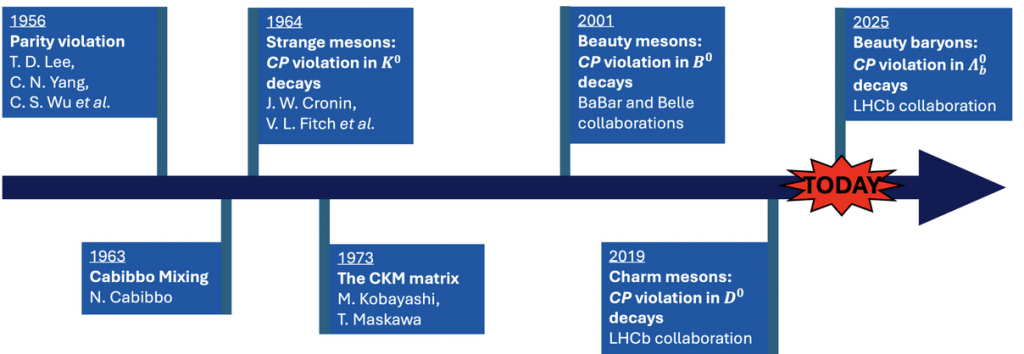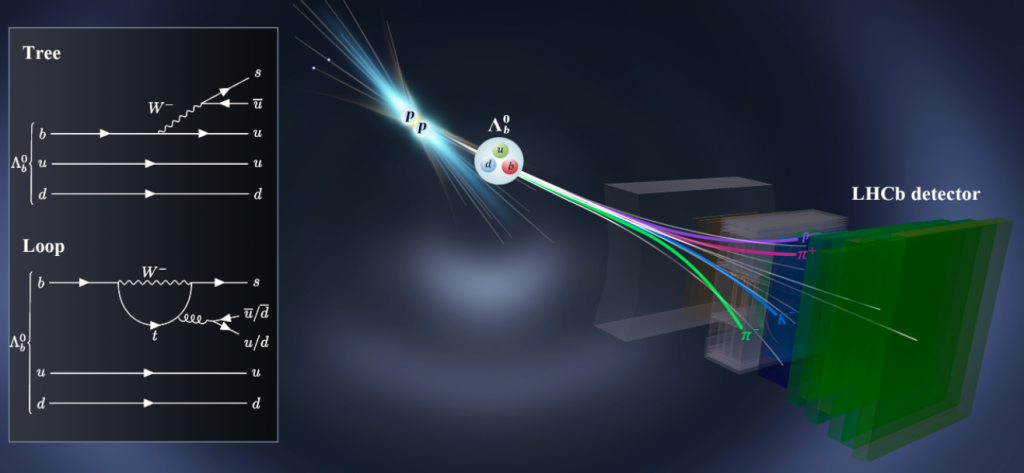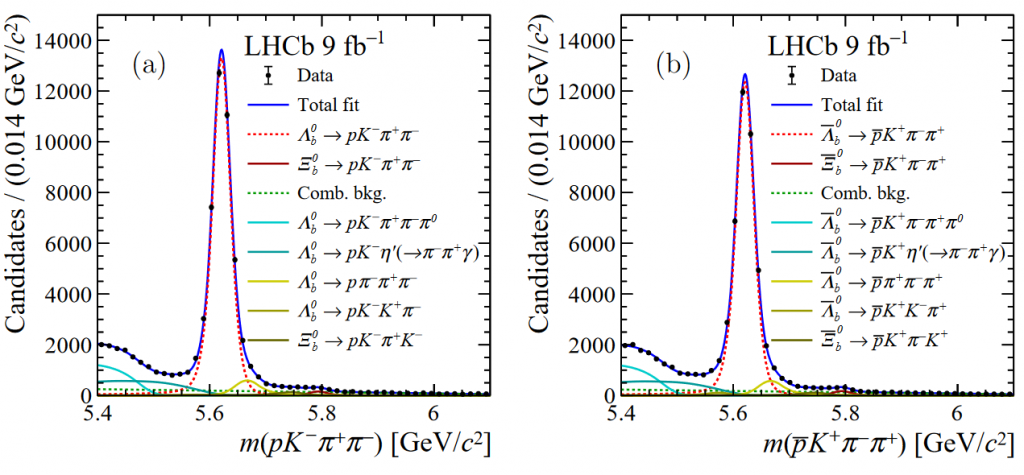First observation of CP violation in baryon decays – an important milestone in the history of particle physics.
Yesterday, at the Rencontres de Moriond EW, the LHCb collaboration reported the first observation of CP violation in baryon decays. The corresponding publication, submitted to Nature, appeared on arXiv. Differences in the properties of matter and antimatter, arising from the so-called phenomenon of CP violation, had been observed in the past using the decays of K, B and D mesons, i.e. of particles composed of a quark-antiquark pair containing strange, beauty and charm quarks, respectively. However, despite decades of experimental searches, CP violation has not been observed yet in the decays of baryons, composed of three quarks, i.e., the type of matter that makes up the visible universe. The result announced today constitutes the first observation of CP violation in baryon decays.

CP violation is one of the key ingredients required to explain why today’s universe is only composed of matter particles, with essentially no residual presence of antimatter. The phenomenon was first observed in 1964 in the decay of neutral K mesons, and the two physicists who made the discovery, James Cronin and Val Fitch, were awarded the Nobel Prize in physics in 1980. Such a discovery came as a great surprise at the time, as it was firmly believed by the community of particle physicists that the CP symmetry was not violated. In the early 1970s, building on the foundations laid by Nicola Cabibbo and others some years before, Makoto Kobayashi and Toshihide Maskawa realised that CP violation could be included naturally in the theoretical framework that we know today as the Standard Model of particle physics provided that at least six different quarks existed in nature. Their fundamental idea was confirmed eventually three decades later thanks to the observation of CP violation in beauty particle decays by the BaBar and Belle collaborations, leading to the award of the 2008 Nobel Prize in physics to Kobayashi and Maskawa. In the Standard Model, the existence and overall size of CP violation are determined by a single parameter, though its manifestation in a particular decay is influenced by several other parameters. The values of these fundamental parameters can be determined experimentally by measuring many different CP-violating processes. The combined set of these measurements, many of which have been performed by LHCb, agree very well with the Standard Model predictions for all CP-violating effects known so far in particle physics.
The observation of CP violation in baryon decays opens a new path for testing the Standard Model and searching for new physics, shedding new light into the CP-violation puzzle.

In this work, CP violation in baryon decays is observed in the decay of the Λb0 baryon to a proton, a kaon, and a pair of oppositely charged pions, represented as Λb0→pK–π+π–. The constituent quarks of the Λb0 baryon are similar to those of the proton (uud), with one of the u quarks replaced by a b quark. CP violation is quantified by the so-called CP asymmetry, A CP, defined as the relative difference between the decay rates of Λb0 (matter) decay and Λb 0 (antimatter) decay to self-conjugate final states. According to the Standard Model, this asymmetry arises from the quantum interference between the “tree” and “loop” quark-level amplitudes of the Λb0 baryon decay, as illustrated in the Feynman diagrams above.

The image above shows the mass distributions of Λb0 and Λb0 decay products. The difference in the number of Λb0 (left) and Λb0 (right) decays, once corrected for experimental effects, is a clear manifestation of CP violation. LHCb physicists obtained the numerical value of the CP asymmetry to be ACP=(2.45±0.46±0.10)%, differing from zero by 5.2 standard deviations. The nonzero value at more than 5 standard deviations implies the observation of CP violation.
A detailed investigation of the Λb0 and Λb0 decays showed that specific intermediate resonances play a key role in generating the observed CP-violating asymmetry.
The first observation ever of CP violation in a baryon decay paves the way for further theoretical and experimental investigations into the nature of CP violation, potentially offering new constraints for models beyond the Standard Model. For more information, see the LHCb Moriond presentation, the LHCb publication, in the Nature article and the CERN press release in English and French.
